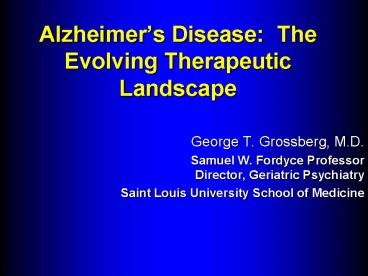Alzheimers Disease: The Evolving Therapeutic Landscape - PowerPoint PPT Presentation
1 / 18
Title:
Alzheimers Disease: The Evolving Therapeutic Landscape
Description:
Ernst RL et al. Arch Neurol. 1997;54:687-693. Who Are the Caregivers? ... Courtesy of George Grossberg M.D.; St. Louis University. Key Risk Factors for AD ... – PowerPoint PPT presentation
Number of Views:203
Avg rating:3.0/5.0
Title: Alzheimers Disease: The Evolving Therapeutic Landscape
1
Alzheimers Disease The Evolving Therapeutic
Landscape
- George T. Grossberg, M.D.
- Samuel W. Fordyce ProfessorDirector, Geriatric
Psychiatry - Saint Louis University School of Medicine
2
Disclosure
- Grant/Research Support Abbott Laboratories,
Cyberonics, Eli Lilly, Forest Laboratories, Inc.,
Novartis, Organon, ONO, Pfizer, Wyeth - Consultant Aztra Zeneca, Bristol-Myers Squibb,
Forest Laboratories, Inc., Janssen, Lundbeck,
Merz Pharmaceuticals, Novartis, Organon, Pfizer,
sanofi-aventis, Sepracor, Synthelabo, Wyeth
3
Alzheimers Disease (AD) More Than Just Memory
Loss
- AD is a progressive, degenerative disease
involving - Loss of memory and other cognitive functions
- Decline in ability to perform activities of
daily living - Changes in personality and behavior
- Increases in resource utilization
- Eventual nursing home placement
4
Alzheimers Disease Overview
- Progressive, degenerative brain disease
characterized by an increasing loss of memory
other cognitive functions - Characterized by changes in activities of daily
living (ADL), behavior personality, cognition
including judgment ABCs - Most common cause of dementia among people aged
65 or over
5
Current Prevalence of AD
- AD is the fourth leading cause of death due to
disease for people gt 65 years of age in the
United States1 - Approximately 4 million people in the United
States have AD2
1. Murphy SL. Natl Vital Stat Rep.
2000481-106. 2. Evans DA et al. Milbank
Quarterly. 199068267-289.
6
Projected Prevalence of AD
4 Million AD Cases TodayOver 14 Million
Projected Within a Generation
14.3
11.3
8.7
6.8
5.8
4
2
0
Year
Evans DA et al. Milbank Quarterly.
199068267-289.
7
AD Is the Most Prevalent Type of Irreversible
Dementia
VaD, vascular dementia DLB, dementia with Lewy
bodies FTD, frontotemporal dementia. reflects
difficulties diagnosing/reporting dementias
only estimations of prevalencecan be made.
100
80
60
Irreversible dementias ()
40
20
0
AD
VaD
DLB
FTD
Other
Guttman R et al. Arch Fam Med. 19998347-353. McK
eith IG et al. Neurology. 1996471113-1124. Cherr
ier MM et al. J Am Geriatr Soc. 199745579-583.
8
Mortality Due to AD Impact of Age
1,000
10
Rate per 100,000 population
100
1
0.1
0.01
Under45
4554
5564
6574
7584
85
Age (years)
Reprinted with permission from Hoyert DL et al.
Natl Vital Stat Rep. 1999471-104.
9
Cost of AD in the United States
- Annual treatment costs 100 billion
- 18,408/patient per year for mild AD
- 30,096/patient per year for moderate AD
- 36,132/patient per year for severe AD
Leon J et al. Health Aff (Millwood).
199817206-216.
10
Does Treatment Affect the Cost of AD?
- Savings are small for mild and very severe AD
- Prevention of even a small decline in cognition
for patients with moderate AD would save
3,700 per patient annually - Relatively small improvements in patients with
moderate AD would save 7,100 per patient
annually
Ernst RL et al. Arch Neurol. 199754687-693.
11
Who Are the Caregivers?
- The overwhelming majority of patients live at
home and are cared for by family and friends - 77 are women
- 73 are over 50 years of age
- 33 are the sole providers
- 45 are children of the patient
- 49 are spouses
- Remainder are close family members or friends
Consumer Health Sciences, LLC. Princeton, NJ
December 1999.
12
Caregiver Burden
- Caregivers spend from 40100 hours per week with
the patient - 90 are affected emotionally (frustrated,
drained) - 75 report feeling depressed 66 have
significant depression - Half say they do not have time for themselves and
that the stress affects family relations - Many experience a significant loss of income
Coping. Available at http//www.alzheimers.com.
Accessed September 2000.
13
Factors That Create Breaking Point for
Caregiver
- Amount of time spent caring for the patient
- Loss of identity
- Patient misidentifications and clinical
fluctuations - Nocturnal deterioration of patient
Annerstedt L et al. Scand J Public Health.
20002823-31.
14
Neuropathological Changes Characteristic of AD
AD
Normal
NFT
AP
AP amyloid plaques
NFT neurofibrillary tangles
Courtesy of George Grossberg M.D. St. Louis
University
15
Key Risk Factors for AD
- Primary risk factors
- Age
- Family history
- Genetic marker such as APOE-4,
- trisomy 21, mutations in presenilin 1,2
- Cardiovascular risk factors e.g.
hyperlipidemia/hypertension (the role of statins
and omega 3 fatty acids) - Possible risk factors
- Head trauma
- Low level of education
- Depression
- Increased zinc?
- Increased homocysteine (the role of B-vitamins,
e.g. Folic acid)
16
AD Is Often Misdiagnosed
- Patient initially diagnosed with AD
Patients first diagnosis other than AD
35
14
14
No 72
9
Yes 28
7
21
Dementia (not AD)
Stroke
Depression
No diagnosis
Normal aging
Other
Source Consumer Health Sciences,LLC.
Alzheimers Caregiver Project. 1999.
17
Treatment Alternatives
- Symptoms
- Non-pharmacological
- Neuroleptics
- Anti-depressants
- Anti-convulsants
- ChEIs
- NMDA receptor antagonists
18
AD Treatment Algorithm
- Stage of AD Mild Moderate
Severe - Treatment
- Options ChEI
ChEI/ Memantine
Memantine - (alone or in (alone or
in - combination)
combination)































